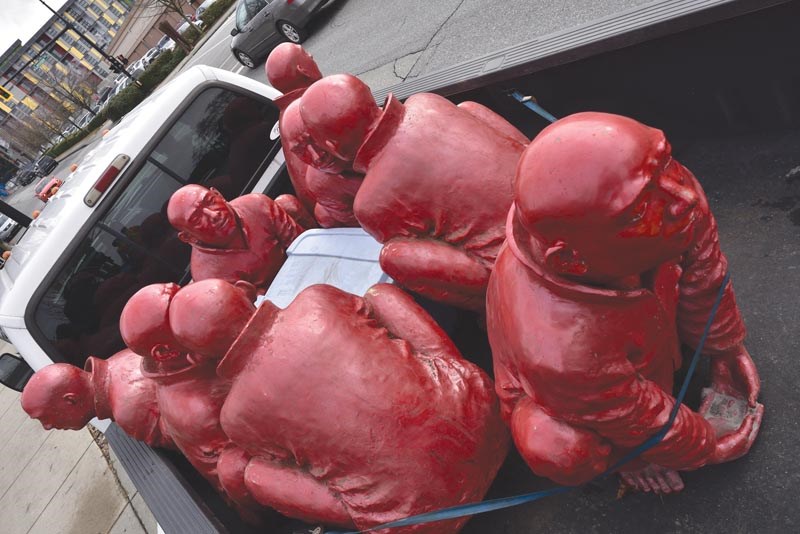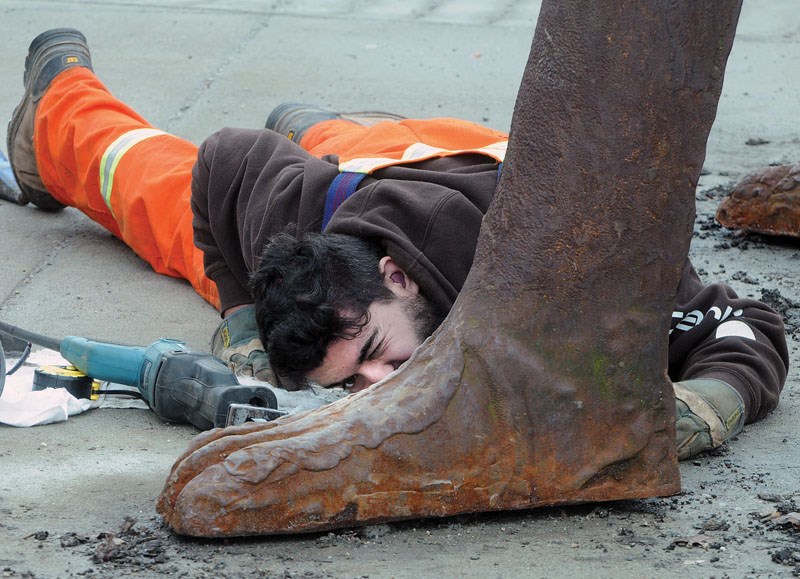These figures were made for walking and that’s just what they’ve done.
The pedestrian artworks that put their feet down along Lonsdale Avenue in 2014 as part of the Vancouver Biennale were removed Wednesday and Thursday, along with the red, crouching monks of Rey Sargent Park.
“Thanks for the great news,” replied Rose Nazeri when informed of the impending departure of Magdalena Abakanowicz’s cast-iron Walking Figures. “I was counting days for the removal of such insulting, so-called ‘artworks.’”
The pieces provoked strong emotions, noted Vancouver Biennale founder and president Barrie Mowatt.
“They certainly shook up a number of people, which I think is an important factor in any art medium,” he noted. “The most natural response is one of, ‘My God, what’s happening here?’”
For Nazeri, who once dubbed the sculptures, “my nightmare,” the works were reminiscent of terrorist groups beheading political opponents.
The “most painful part” of the display was that the figures were erected in an area populated with immigrants who have seen the consequences of war, according to Nazeri.
Many city residents have come to appreciate the sculptures, according to Lori Phillips, an officer with the North Vancouver Public Art Advisory Committee.
“It’s something that took the community a little while,” she acknowledged. However, Phillips said she heard from plenty of Central Lonsdale commuters who came to love them.
“Those artworks reached an emotional core with people … and sometimes it makes you feel good and sometimes it makes you feel uncomfortable,” she said.
The Walking Figures are slated to toe the line in Montreal, Que., as part of an outdoor exhibition celebrating Canada’s 150th birthday and the city’s 375th anniversary.
“I’m glad Montreal’s getting them,” said painter Dene Croft with a chuckle.
Croft – who did not warm to the works – likened the sculptures to a “big, ugly wart.”
“I guess I got used to them but not in a good way,” he said.
Croft said he’d prefer to see art from local artists.
“There’s so many great local, sculptural, figurative artists,” he said.
Injecting a city street with “high art” is always going to create “some kind of buzz or engagement,” according to Mowatt.
Generally, the art is treated like a new neighbour, Mowatt explained.
“They either like the new neighbours or they ignore the new neighbours,” he said.
While it’s possible Wang Shugang’s eight crouching monks collectively known as The Meeting will return – the asking price is expected to be US$220,000 – the Walking Figures will likely never find arch support on the North Shore again, according to Mowatt.

Four of the leggy models were sold to collectors at approximately $285,000 each, according to Mowatt.
“A part of me is sad to see them go but of course the important part of the Biennale is that most works are temporary,” Mowatt said.
The Walking Figures were originally clustered together in Chicago’s Grant Park.
While artists tend to avoid revealing the entirety of their intention with a piece, Mowatt said he suspects the initial idea of the figures was to suggest that while in large groups: “people tend to act in a mindless way.”
Mowatt acknowledged that the North Vancouver placement “took liberty” with Abakanowicz’s vision by spreading them across the street.
Mowatt said the decision was made to make the figures “much more part of the pedestrian, everyday life.”
The Vancouver Biennale founder singled out City of North Vancouver Mayor Darrell Mussatto for supporting the installation, complimenting his “political courage.”
“I know I had certain politicians scared,” he says. “To their credit they hung in there.”
The Vancouver Biennale is a non-profit charitable organization funded through grants, corporate sponsorship, in-kind gifts, philanthropic donations and the sale of art after each of its two-year exhibitions.



